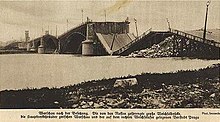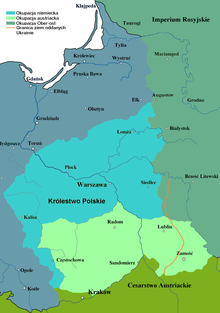History of Poland during World War I
| Part of Austro-Hungarian Empire | |
| Outcome | 1,400,000 Poles conscripted into the Austro-Hungarian army 1,200,000 Poles conscripted into the Russian army 700,000 Poles conscripted into the German army Collapse of all three occupying Empires Establishment of the Second Polish Republic. |
|---|---|
| Deaths | 450,000-600,000 military deaths 1,128,000 deaths overall |
| Property damage | Destruction of over 1,800,000 buildings and half of the bridges Production output fell to 20% of its level before the war Polish industry suffered the loss of an estimated 73 billion French francs. |
| Displaced | 800,000 deported by Russians to the east Hundreds of thousands taken to labor camps in Germany |
This article needs additional citations for verification. (May 2012) |
| History of Poland |
|---|
 |
While Poland did not exist as an independent state during World War I, its geographical position between the fighting powers meant that much fighting and terrific human and material losses occurred on the Polish lands between 1914 and 1918.
When World War I started, Polish territory was split during the
In the
Split of Three Empires


The war split the ranks of the three partitioning empires, pitting Russia as defender of Serbia and ally of Britain and France against the leading members of the Central Powers, Germany and Austria-Hungary.
Conflicting aims of empires
This circumstance afforded the Poles political leverage as both sides offered pledges of concessions and future autonomy in exchange for Polish loyalty and army recruits.
The Austrians wanted to incorporate the Russian territory of
The Russians recognized the Polish right to autonomy and allowed formation of the Polish National Committee, which supported the Russian side. Russia's foreign Minister Sergei Sazonov proposed to create an autonomous Kingdom of Poland with its own internal administration, religious freedom and Polish language used in schools and administration.[1] Poland would receive eastern area of Poznań region, southern Silesia and Western Galicia.[2]
As the war settled into a long stalemate, the issue of Polish self-rule gained greater urgency. Roman Dmowski spent the war years in Western Europe, hoping to persuade the Allies to unify the Polish lands under Russian rule as an initial step toward liberation.
In June 1914,
The encroaching German forces were met with hostility and distrust. Unlike the Napoleonic forces a century earlier, Poles didn't see them as liberators.
The Russians were bid farewell, often with sadness, grief and uncertainty. There was no harassment of retreating Russian soldiers, nor attacks on wounded. For many Poles, Russians at that time were seen as "ours," due to the process of liberalization that occurred in the Russian Empire after the
According to Prit Buttar, following the first year of fighting in 1914, "The people who suffered the most were those who had no national army serving their cause: the Poles. Most of Poland west of Warsaw had been turned into a battlefield, and large areas were deliberately devastated by the Germans during their retreat from the Vistula. Treated with disdain by Germans, Russians, and the Austro-Hungarians alike, the Poles could only endure through a cold winter in their shattered towns and villages, and hope for a better future."[4]
Kingdom of Poland (1916–1918)
In 1916, attempting to increase Polish support for the Central Powers and to raise a Polish army, the German and Austrian emperors declared that a new state called the Kingdom of Poland would be created. The new Kingdom in reality was to be a
After peace in the East was assured by the
Battlefields


Much of the heavy fighting on the war's Eastern Front took place on the territory of the former Polish state. In 1914 Russian forces advanced very close to
450,000 Poles died and around one million were wounded while fighting in the
"The country...had undergone four or five occupations by different armies, each of which had combed the land for supplies. Most of the villages had been burnt down by the Russians and their retreat (of 1915); land had been uncultivated for four years and had been cleared of cattle, grain, horses and agricultural machinery by both Germans and Bolsheviks. The population here was living upon roots, grass, acorns and heather. The only bread obtainable was composed of those ingredients, with perhaps about 5 per cent of rye flour..."
The lack of food caused widespread malnutrition, which combined with disease often brought by soldiers returning from the front, drove up the mortality rate of the local population. Famine conditions affected a significant area of eastern Poland.[12]
Military formations
| Polish I Corps | Polish II Corps | |||
|---|---|---|---|---|
|
| |||
Recovery of statehood
In 1917 two separate events decisively changed the character of the war and set it on a course toward the rebirth of Poland. The
The defection of Russia from the Allied coalition gave free rein to the calls of Woodrow Wilson, the American president, to transform the war into a crusade to spread democracy and liberate the Poles and other peoples from the suzerainty of the Central Powers. The thirteenth of his Fourteen Points adopted the resurrection of Poland as one of the main aims of World War I. Polish opinion crystallized in support of the Allied cause.
The newly created state initially consisted of former
See also
- History of Poland (1795–1918)
- History of Poland (1918–1939)
- Diplomatic history of World War I
- Kingdom of Poland (1917–1918)
References
- ^ R.F. Leslie, ed. The history of Poland since 1863 (Cambridge UP, . (1983). p 98
- ^ A companion to international history 1900-2001 Gordon Martel, page 126, July 2007, Wiley-Blackwell
- ^ See:
- Józef Piłsudski: Polish revolutionary and statesman (Encyclopædia Britannica)
- Winkler, Heinrich August; Spencer, Stewart, trans. (2015). The Age of Catastrophe: A History of the West, 1914–1945. New Haven, Connecticut, USA: Yale University Press. p. 81. ISBN 9780300204896.)
{{cite book}}: CS1 maint: multiple names: authors list (link
- Roos, Hans; Foster, J.R., trans. (1966). A History of Modern Poland, from the Foundation of the State in the First World War to the Present Day. New York, New York, USA: Knopf. p. 14.
{{cite book}}: CS1 maint: multiple names: authors list (link) - ^ ISBN 9781472813183.
- ^
- ^ a b R. Bideleux, I. Jeffries. A History of Eastern Europe: Crisis and Change. Routledge. 1998. p. 186
- ^ a b Andrzej Gawryszewski (2005). Ludnosc Polski w XX wieku. Warsaw.
{{cite book}}: CS1 maint: location missing publisher (link) - ISBN 9780754626343.
- ^ ISBN 9781138359666.
- ^ German army, 1914–1918: Histories of two hundred and fifty-one divisions, WWI | World War One Resource Centre | Great War History | www.vlib.us/wwi/resources/. Vlib.us. Retrieved on 2011-06-12.
- ^ Cavalry Regiments 1914. Austro-Hungarian Army. Retrieved on 2011-06-12.
- ^ Units of the Polish Army in France, Haller Army, Blue Army. Hallersarmy.com. Retrieved on 2011-06-12.
Further reading
External links
- Articles relating to Poland at the International Encyclopedia of the First World War.
- Szlanta, Piotr: Poland , in: 1914-1918-online. International Encyclopedia of the First World War.
- Posters of the German Military Government in the Generalgouvernement Warshau (German occupied Poland) from World War I, 1915-1916 From the Collections at the Library of Congress

